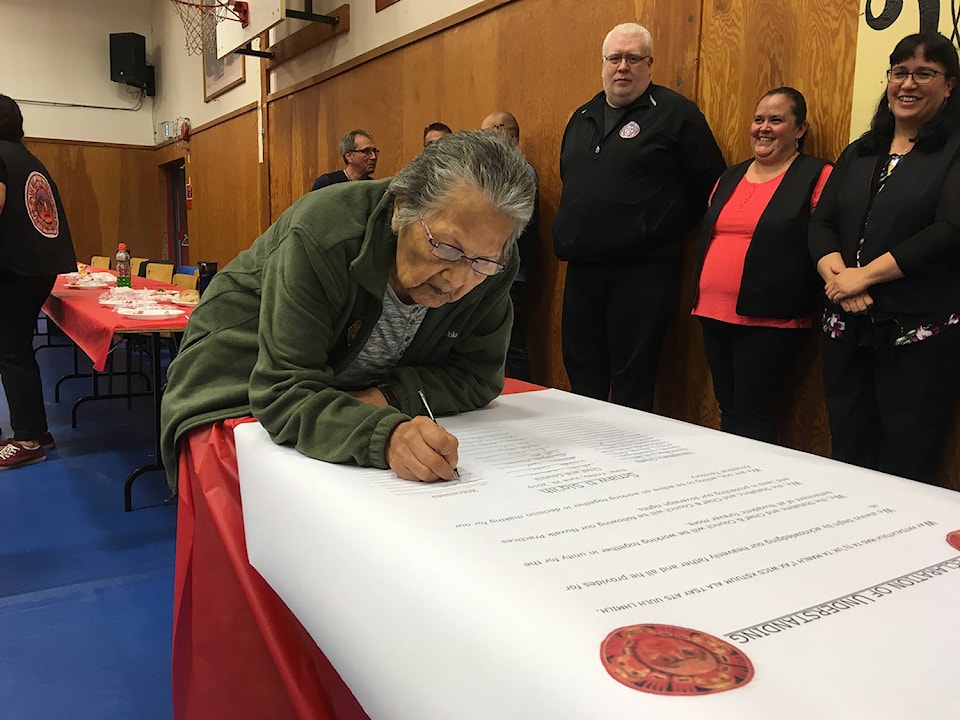History was made on June 28 when a Declaration of Understanding was signed between the hereditary and elected leadership of the Nuxalk Nation.
The agreement, which was six years in the making, outlines the path that the leadership intends to take moving forward and lays a foundation for future cooperation.
Traditional leadership in Indigenous communities looked markedly different than it does today. Every family group, which descended to various regions within Nuxalk Ancestral Territory, had a traditional hereditary chief (Staltmc) who was responsible for overseeing Nuxalk Traditional Laws.
The Staltmc are still very active in Nuxalk territory but have faced significant challenges in re-establishing their leadership in regard to their respective territories, especially in the face of the imposed electoral system.
The Indian Act was first passed in 1876 and although it has undergone numerous amendments since then, it largely retains its original form. European style elections were first introduced into the Act on June 22, 1869, and the intention of the Canadian government was to replace the traditional Indigenous systems with one that closely mirrored their own. Under the Indian Act individuals are elected by the community but are accountable to Indigenous and Northern Affairs Canada.
Around 200 First Nations in Canada hold elections under the Indian Act and the Indian Band Election Regulations. Under the act, elections must be held every two years. In 2015 the First Nations Election Act came into effect, which differs slightly from the Indian Act but does not change the election system. However, there are some significant changes, such as elections every four years instead of two.
Self-governing First Nations do not fall under the Indian Act and establish their own laws and policies according to their cultures and traditions, including leadership selection. Self-governing First Nations elect their leadership through individual election processes which vary depending on the First Nation and are often unique to the specific community.
The role and responsibilities of First Nation Chiefs, traditional or elected, are not easily defined, and are not synonymous across Canada due to the range of traditions in First Nations culture.
While the Nuxalk Nation still holds its elections according to the Indian Act, this declaration of understanding represents a new direction for both hereditary and elected leadership.
“How many of you would like to see unity in our community? To be a unified nation?” Chief Noel Pootlass asked the crowd. “If we are divided, we are weak; if we become one, we are very strong. It’s a blessing to come together tonight.”
The declaration is the first of its kind to be ratified between the two systems of leadership, and while details of how it will look in practice are ongoing, the mood during the signing was positive and upbeat.
“I really am in awe of what’s happening tonight, it’s such an historic event” said Chief Anuspuxals (Jeff Snow). “We’re putting two systems to agree to work together and it’s something that hasn’t happened very much in the past. It was like mixing oil and water.”
Elected Chief Wally Webber (also a Staltmc) was visibly emotional during his address to the crowd.
“It’s been six years in the making and there’s still a lot more work to do,” said Webber. “When we work together, we’re going to go a long way. I’m very proud of the Staltmc and Chief and Council for coming together. Today is an awesome day.”
Before the agreement was signed Chief and Council presented the Staltmc with vests depicting the crest that represents the symbol of the Nation: the image of the sun mask that many have become to associate with the Nuxalk people.
The declaration states that the Staltmc and the Chief and Council will be working together in unity for the betterment of all Nuxalkmc, will be following Nuxalk practices and laws in protecting their sovereign rights, and are willing to be active in decision making together for the ancestral territory.
The declaration was then signed by attending Staltmc and members of Chief and Council. It was witnessed by Nuxalk elders and youth.
“We’re gifted our teachings, practices, and our laws, from the creator (Alhkw’ntam) and we need to remember that Nuxalkmc managed this territory when there was 10,000 people here,” said culturalist Snxakila (Clyde Tallio). “All aspects of our lives were governed by it. Now the two systems are coming together as one for the benefit of all Nuxalk people.”
